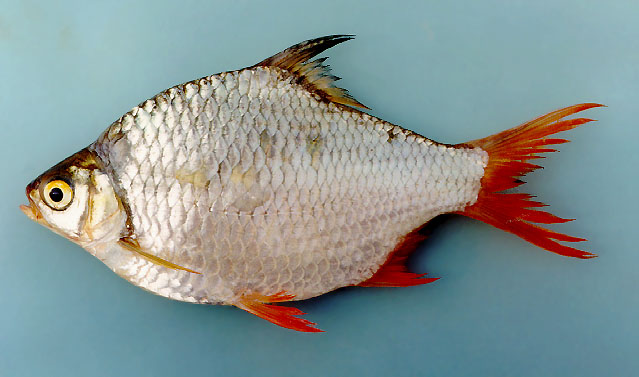| Cyprinidae (Minnows or carps), subfamily: Cyprininae |
| 25 cm TL (male/unsexed) |
|
benthopelagic; freshwater, potamodromous |
| Asia: Mekong and Chao Phraya basins (Ref. 27732). Recorded from the Maeklong, Peninsular and Southeast Thailand river systems (Ref. 26336). |
|
Broad red distal margin with no black submarginal stripe along each lobe of the caudal fin; red pelvic and anal fins; a black distal blotch on the dorsal fin; the body depth 1.8-2.2 times in standard length (Ref. 27732). |
| Occurs at midwater depths in large and medium-sized rivers and floodplains. Feeds on various plant and animal matter. Commonly found near villages where it feeds on organic detritus disposed of by humans (Ref. 12693). Reported to be occasionally poisonous, causing vomiting, due the fruits it eats (Ref. 12369). Colonizes inundated forests and adults migrate back to the river in October. Young of the year follow thereafter when the water levels recede. Large-sized fish are marketed fresh while smaller ones are used to make prahoc and nuoc mam (Ref. 12693). Popular fish in the aquarium trade where it is sold under the name of "tinfoil barb" (Ref. 12693). Captured from the wild for the ornamental fish trade in Thailand (Ref. 6459). Cultured in floating cages in Viet Nam (Ref. 12693). |
|
Least Concern (LC); Date assessed: 25 January 2019 Ref. (130435)
|
| harmless |
|
Occurs in the Mekong and the lower Xe Bangfai (Ref. 27732). Found below the Mun-Chin River to the Knone Falls (Ref. 37772) and at Hat Village in Muang Khong District (Ref. 37769). Reported to migrate upstream during the dry season in December/January in Southern Laos (Ref. 37769). Recent decline in fisheries attributed to "lee" (large immobile wing traps used in rapids below Lee Pee). Upstream non-reproductive migration occurs in Jan-Feb lasting 1 wk - 10 days and downstream migrations in May-July at night in Ban Hang Khone, just below the great waterfalls of the Mekong River (Ref. 9497). Observed to undergo migration at the fishing village of Ban Wernsonkhram on Don Hat (Hat Island) above the Lee Pee Waterfalls (Ref. 10431). This species is occasionally poisonous, causing vomiting, due to the fruits it has eaten (Ref. 12369). Museum: Mekong, CAS 96270 (near Ban Hang Khone), CAS 93464 (just below Khoné falls) (Ref. 5515). Also Ref. 4792, 9497, 30857, 36654, 37767, 44002, 56905. |
Source and more info: www.fishbase.org. For personal, classroom, and other internal use only. Not for publication.

